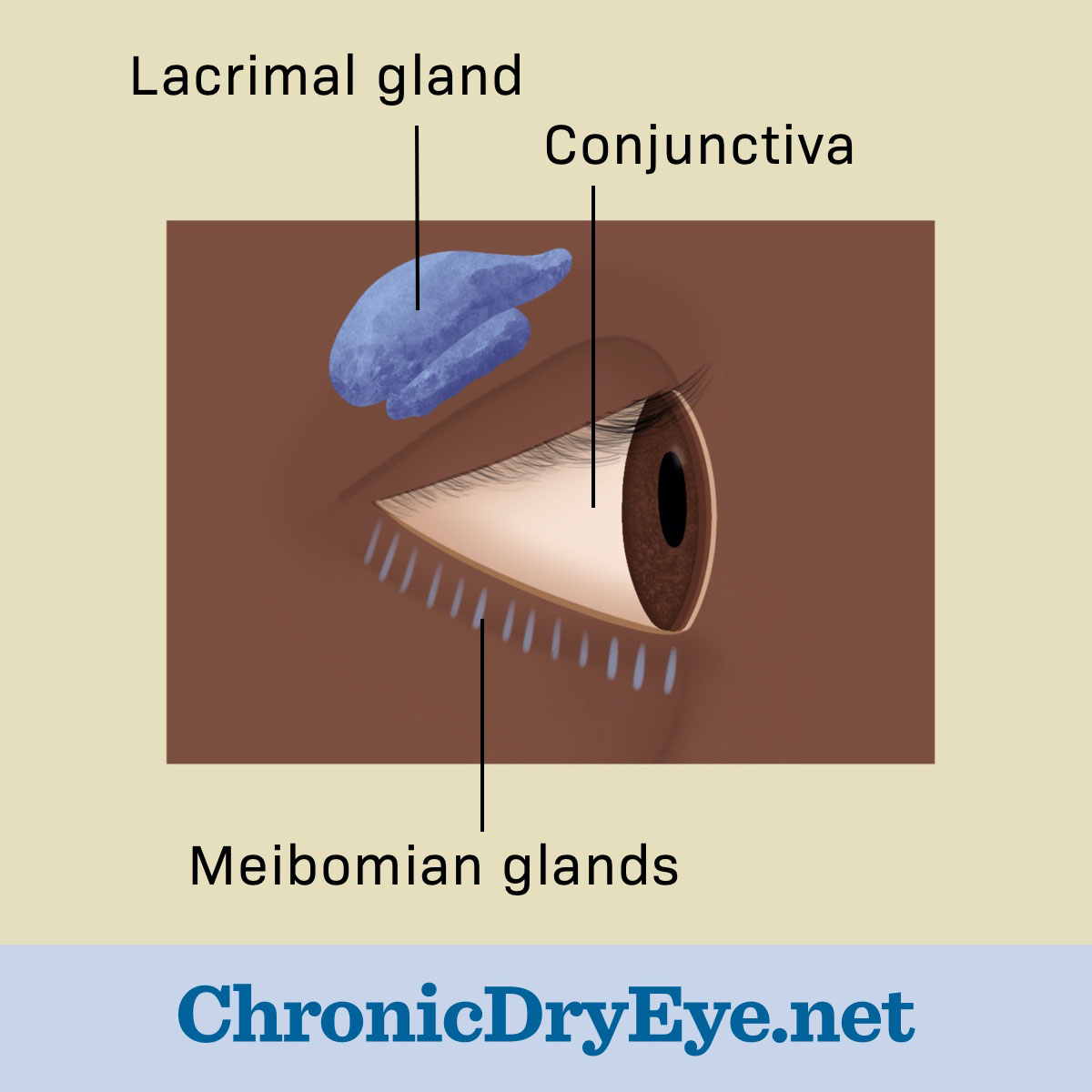Glossary of Chronic Dry Eye Terms
Reviewed by: HU Medical Review Board | Last updated: May 2021
A
Aqueous deficient dry eye
Type of chronic dry eye disease that occurs due to a decrease in the amount of tears produced. With this type, tears evaporate at a normal rate, but not enough tears are present. This type accounts for about 10 percent of chronic dry eye cases.1
C
Chronic
Word used to describe long-term. This is often used to describe a longstanding disease or condition.2
Conjunctiva
A thin, clear tissue that covers the surface of the eye. This tissue has many blood vessels that help keep the surface of the eye healthy. The bulbar conjunctiva is the part that covers the sclera (white part of the eye), and the palpebral conjunctiva is the part that covers the inner surface of the eyelids. The blood vessels of the conjunctiva can become dilated (enlarged) and inflamed in chronic dry eye and other conditions that affect the eye surface, giving the eye a red appearance.
Cornea
A thin, clear membrane on the surface of the eye. The cornea serves 2 main purposes: protection and refraction (bending) of light for normal vision.2
D
Dry eye disease (DED)
Another name used to describe chronic dry eye disease.1
Dry eye syndrome (DES)
Another name used to describe chronic dry eye disease.1
E
Evaporative dry eye
The most common type of chronic dry eye disease, accounting for 85 to 90 percent of cases. In this type, a normal amount of tears are made but they evaporate too quickly. Evaporative dry eye is commonly associated with a blockage or problem with the meibomian glands of the eyelids. These glands secrete the oily tear film layer, which normally serves to slow the evaporation of tears.1
G
Glands of Krause and Wolfring
Glands located on the inside surface of the eyelids that make the baseline watery layer of the tear film.3
I
Immune-modulating eye drops
Prescription eye drops that may be used in the treatment of chronic eye disease. These drops work on the surface of the eye to decrease inflammation. They may also substitute, preserve, or increase the production of tears.4
K
Keratoconjunctivitis sicca
Another name used to describe chronic dry eye disease.5
L
Lacrimal gland
Located next to the eye in the bony orbit, the lacrimal gland secretes the watery layer of the tear film. The lacrimal gland is most active in reflex tearing, such as when an onion causes a person to produce tears.2
M
Meibomian glands
Glands located on the edge of the eyelids that secrete (discharge) an oil that is part of the tear film. This oil helps to keep tears from evaporating too quickly.2,6
Figure 1: Locating various glands
Monocular diplopia
Double vision in 1 eye only. Those with dry eye disease often report “double vision,” but this is not truly “double” vision. Instead, it is a shadowing effect from light scattering due to an abnormal tear film or abnormal shape of the cornea. True double vision is usually caused by a misalignment of the 2 eyes and abnormalities of the eye muscles.7
Mucin
The protein building block for the mucus inner layer of the tear film that coats the surface of the eye. It is secreted (discharged) by goblet cells located on the surface of the eye and inner surface of the eyelids.8
O
Ocular surface
The outer surface of the eye. This includes the conjunctiva, the cornea, the glands involved in tear production, and the tear film itself.8,9
Ophthalmologist
An ophthalmologist is a doctor (MD or DO) specializing in eye care and vision. These doctors have completed 4 years of medical school and at least 4 years of additional training in diagnosing and treating conditions of the eye. Ophthalmologists are licensed to practice medicine and surgery. Like other medical doctors, ophthalmologists might also do research on the causes and treatments for various eye conditions.10
Optometrist
Optometrists (OD) are healthcare professionals who provide a wide range of primary vision care. An optometrist is not a medical doctor. An optometrist completes 3 or more years of college, in addition to 4 years of optometry school. Optometrists are licensed to practice optometry but are not trained in general medicine or surgical procedures of the eye.10
P
Photophobia
Sensitivity or intolerance to light. This is a common symptom of chronic dry eye.11
R
Regenerative eye drops
Prescription eye drops that work to regenerate (regrow) and repair the tissue on the surface of the eye.12
Retina
A thin, clear structure covering the inner wall of the back of the eye. When you look at something, the images are first projected onto the retina before traveling through the optic nerve to the brain.2
S
Sjogren’s syndrome
An autoimmune disorder in which the glands that produce tears and saliva do not work properly. Chronic dry eye is often diagnosed in those with this disorder.13,14
T
Tear film
The thin fluid layer that covers the surface of the eye. The tear film is made up of 3 layers: an oily layer on the outside, a watery layer in the middle, and a mucus layer on the inside.6
